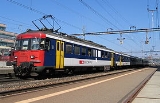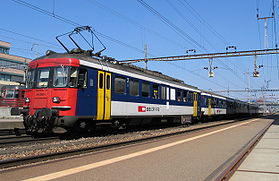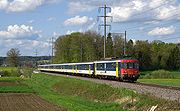
SBB-CFF-FFS RBe 540
Encyclopedia
 |
|
| Operation | |
|---|---|
| Build date | 1959, 1963–1966 |
| Road numbers | 1401 – 1482 |
| Total production | 82 |
| Rebuild (R4) | 1993–1998 |
| Road numbers (UIC) | RBe 540 006 – RBe 540 079 (Prototypes 1401–1406 got no UIC numbers) |
| Units still existing (end of 2000) | 78 |
| Services | Commuter and S-Bahn traffic |
| End of operation | due to accidents (4) due to old age (3) |
| Technical data | |
| Vehicle type | electric multiple unit |
| Builder | SIG Schweizerische Industrie Gesellschaft Schweizerische Industrie Gesellschaft , or SIG, is the former name of SIG Holding AG, a Swiss company that has been active in various businesses during its more than 150 years of operation. Since the year 2000 the Society has undergone strategic refocus, concentrating on its core compentence in... Neuhausen Neuhausen Neuhausen may refer to:*Neuhausen am Rheinfall, a town in the canton of Schaffhausen, Switzerland*Neuhausen auf den Fildern, a municipality in Baden-Württemberg, Germany*Neuhausen , a municipality in Baden-Württemberg, Germany... BBC Brown, Boveri & Cie Brown, Boveri & Cie was a Swiss group of electrical engineering companies.It was founded in Baden, Switzerland, in 1891 by Charles Eugene Lancelot Brown and Walter Boveri who worked at the Maschinenfabrik Oerlikon. In 1970 BBC took over the Maschinenfabrik Oerlikon... Baden MFO Zürich Zürich Zurich is the largest city in Switzerland and the capital of the canton of Zurich. It is located in central Switzerland at the northwestern tip of Lake Zurich... |
| Wheel arrangement Wheel arrangement In rail transport, a wheel arrangement is a system of classifying the way in which wheels are distributed beneath a locomotive.. Several notations exist to describe the wheel assemblies of a locomotive by type, position, and connections, with the adopted notations varying by country... |
Bo'Bo' |
| Top speed Top Speed Top Speed is a 1930 American musical comedy film released by First National Pictures, a subsidiary of Warner Brothers.-Production:The film was completed as a full musical... |
125 km/h |
| Motive power Motive power In thermodynamics, motive power is an agency, as water or steam, used to impart motion. Generally, motive power is defined as a natural agent, as water, steam, wind, electricity, etc., used to impart motion to machinery; a motor; a mover. The term may also define something, as a locomotive or a... |
1988 kW at 80 km/h |
| Continuous Tractive Effort | 89 kN |
| Maximum Tractive Effort | 167 kN |
| Size and weight | |
| Length over buffers | 23'700 mm |
| Width | ? mm |
| Height | ? mm |
| Weight | 68 t / after R4: 72 t Prototypes: 64 t |
| Equipment | |
| Train formation | RBe |
| Seats | 64 / after R4: 60 |
| first class | 0 |
| second class | 64 / after R4: 60 |
| Other | |
| Special characteristics | Front doors; Completely immersible baltlings for the passage to passenger carriages Upgraded to thyristor switching starting 1992 |
| Predecessors | BDe 4/4, Be 4/6, De 4/4 |
| Successors | RBDe 560 SBB-CFF-FFS RBDe 560 The RBDe 560 and its derivatives provide motive power for S-Bahn, suburban, and regional traffic on the Swiss Federal Railways network. The derivative versions belong to the SBB as well as various private railroads... , Re 450 |
Starting in 1959, the SBB-CFF-FFS
SBB-CFF-FFS
Swiss Federal Railways and SFR are not in official use) is the national railway company of Switzerland headquartered in Bern. Formerly a government institution, it is since 1999 a special stock corporation with all shares held by the Swiss Confederation or the Swiss cantons...
put motored coaches of the type RBe 540 (old designation RBe 4/4) into service for push-pull operation on the Gotthard line
Gotthardbahn
Gotthardbahn was the name of a private Swiss railway company which operated the railway line from Immensee to Chiasso . Nowadays this term usually does not refer to that company, but to the railway line itself...
. As a consequence, they had much power at their disposal, even more than the Re 4/4 I locomotives, a regenerative brake
Regenerative brake
A regenerative brake is an energy recovery mechanism which slows a vehicle or object down by converting its kinetic energy into another form, which can be either used immediately or stored until needed...
, cabs on both ends with doors to passenger carriages as well as multiple-unit train control (SBB Vst III), which is compatible with the Bt and NPZ
SBB-CFF-FFS RBDe 560
The RBDe 560 and its derivatives provide motive power for S-Bahn, suburban, and regional traffic on the Swiss Federal Railways network. The derivative versions belong to the SBB as well as various private railroads...
control cars
Control car (rail)
A control car is a generic term for a non-powered railroad vehicle that can control operation of a train from the end opposite to the position of the locomotive...
, as well as the locomotives of the Re 420 series
SBB-CFF-FFS Re 420
The Re 420, originally Re 4/4II series are the most common electric locomotives of the Swiss Federal Railways. They are used for passenger services throughout Switzerland alone or in pairs. For freight services, they are sometimes paired with the Re 620, especially in mountainous regions...
(Re 4/4II = Re 420, Re 421, Re 4/4III), Re 4/4 IV and Re 620
SBB-CFF-FFS Re 620
The Re 620, Re 6/6 in the old numbering scheme, are six-axle, electric locomotives of the SBB-CFF-FFS, which were acquired as a replacement for the Ae 6/6 for heavy services on the Gotthardbahn...
. They originally had 64 seats, 32 smoking and 32 non-smoking, and were painted in ordinary SBB-CFF-FFS green.
The first six prototypes, each costing six million francs, were delivered 1959 and 1960, and first shown to the press at the 24th May 1959. The prototypes had some issues which were fixed until the series production. The series units were four tonnes heavier, and 76 units were ordered, which were put into service between 1963 and 1966.
Most of the technical equipment is installed below the passenger compartment, leading to a higher than usual floor level than ordinary carriages had. Some of the equipment and the toilet is installed in the middle of the multiple unit, instead of passenger compartments. The conventional transformer technology with its rough step controller (28 running notches) together with occasional heavy vibrations led to the nickname "Schüttelbecher" ("shaker").
Starting in 1992, all units (except for the prototypes) were modernized to fit the needs of S-Bahn operations. This included cloth seats instead of the plastic ones and some other interior modifications, NPZ
SBB-CFF-FFS RBDe 560
The RBDe 560 and its derivatives provide motive power for S-Bahn, suburban, and regional traffic on the Swiss Federal Railways network. The derivative versions belong to the SBB as well as various private railroads...
livery, automatic doors for conductor-less operation as well as the installation of an additional thyristor controller, for which a passenger compartment had to be given up. The latter improved running smoothness considerably, especially when using the regenerative brake. At the same time, they were renumbered to the UIC scheme, which led to some inconsistencies due to vehicles already retired from service:
- RBe 540 006-4 to 540 017-1: Former units 1407 - 1418
- RBe 540 018-9 to 540 051-0: Former units 1420 - 1453
- RBe 540 052-8 to 540 079-1: Former units 1455 - 1482
The prototypes, which never got UIC numbers, got the nicknames "Seetal-RBe 4/4", due to their special warning livery for services on the dangerous Seetalbahn
Seetalbahn
The Seetalbahn is a railway of the Swiss Federal Railways between Lenzburg and Lucerne in Switzerland. The track, when created, was originally named the Swiss Lake Valley Railway Company and was owned by British investors. The passengers included tourists from Lucerne doing sightseeing tours to...
.
So far, the prototypes 1401-1403 (due to old age), 1419 (accident in St.-Triphon), 1454 (fire between Uster and Aatal in 1990), 540 008 (fire between Safenwil and Walterswil-Striegel, 1998) and 540 023 (fire at Eglisau, 2000) were discarded. RBe 540 019 was sold to the Oensingen-Balsthal Bahn.
Operation


Control car (rail)
A control car is a generic term for a non-powered railroad vehicle that can control operation of a train from the end opposite to the position of the locomotive...
BDt or Bt for commuter service. Together with their modernization, the EW I/II and control cars were also modernized to match the new livery. Nowadays, these consists serve regional lines with low passenger frequencies and supplement services normally run by NPZ
SBB-CFF-FFS RBDe 560
The RBDe 560 and its derivatives provide motive power for S-Bahn, suburban, and regional traffic on the Swiss Federal Railways network. The derivative versions belong to the SBB as well as various private railroads...
consists, but are progressively replaced by the modern Stadler GTW
Stadler GTW
The Stadler GTW, sold by Stadler Rail of Switzerland, is an articulated railcar for local transport. GTW stands for Gelenktriebwagen .-Description:...
. On the S-Bahn Zurich network, special consists can be seen, consisting of two RBe 540 on the front and back of the train with six modernized EW I or II in between, which avoids the pointless use of control cars, because shorter consists couldn't provide enough capacity anyway and a single multiple unit would not be able to deliver enough acceleration for S-Bahn operation. The free control cars are used together with EW I/II and Re 4/4II locomotives to create more push-pull trains.
Some RBe 540 rented from Thurbo
THURBO
THURBO is the corporate identity of a railway company in eastern Switzerland, owned by SBB-CFF-FFS and the canton of Thurgau.-Operations:...
were also used by the S-Bahn St. Gallen until 2005, together with an EW AB and a BDt.
It also happens during wintertime that RBe 540 have to replace the newer RBDe 560 multiple units, often due to issues with the doors; then one can see RBe 540 multiple units together with NPZ
SBB-CFF-FFS RBDe 560
The RBDe 560 and its derivatives provide motive power for S-Bahn, suburban, and regional traffic on the Swiss Federal Railways network. The derivative versions belong to the SBB as well as various private railroads...
control cars, living up to the joke about the name NPZ (NPZ = Nichts Passt Zusammen = "nothing fits together").

